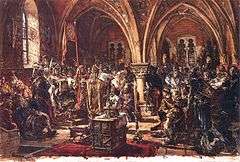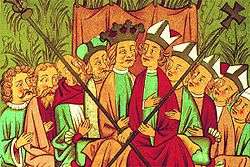Sejm of the Kingdom of Poland

The general sejm (Polish: sejm walny, also translated as the full or ordinary sejm) was the parliament of Kingdom of Poland. It had evolved from the earlier institution of wiec. It was one of the primary elements of the democratic governance in the Kingdom of Poland. The sejm was a powerful political institution, and from early 16th century, the Polish king could not pass laws without the approval of that body. The Sejm and the Seimas of the Grand Duchy of Lithuania was merged into the Sejm of the Polish–Lithuanian Commonwealth by the Union of Lublin in 1569.
Duration and frequencies of the sejms changed over time, with the six-week sejm session convened every two years being most common. Sejm locations changed throughout history. The number of sejm deputies and senators grew over time. Sejms have seen mostly majority voting.
The word sejm and sejmik are derived from old Czech sejmovat, which means "to bring together" or "to summon".[1] In English, the terms general,[2] full[3] or ordinary[4] sejm are used for the sejm walny.
History

There is no obvious date for the first sejm. Public participation in policy making in Poland can be traced to the Slavic assembly known as the wiec.[5] Another form of public decision making was that of royal election, which occurred when there was no clear heir to the throne, or the heir's appointment had to be confirmed.[6] There are legends of a 9th-century election of the legendary founder of the Piast dynasty, Piast the Wheelwright, and a similar election of his son, Siemowit (this would place a Polish ruler's election a century before an Icelandic one's by the Althing), but sources for that time come from the later centuries and their validity is disputed by scholars.[7][8] The election privilege was usually limited to the most powerful nobles (magnates) or officials, and was heavily influenced by local traditions and strength of the ruler.[6] By the 12th or 13th centuries, the wiec institution likewise limited its participation to high ranking nobles and officials.[9] The nationwide gatherings of wiec officials in 1306 and 1310 can be seen as precursors of the general sejm.[9]
The traditions of local wiec's or sejmiks survived the period of Poland's fragmentation (1146–1295), and continued in the restored Kingdom of Poland.[10][11] Sejmiks proper date to the late 14th century when they arose from gatherings of nobility, formed for military and consultative purposes.[1] Sejmiks were legally recognized by the 1454 Nieszawa Statutes, in a privilege granted to the szlachta (Polish nobility) by King Casimir IV Jagiellon, when the King agreed to consult certain decisions with the nobility.[1][12][13] Such local gatherings were preferred by the kings, as national assemblies would try to claim more power than the regional ones.[10][14] Nonetheless, with time the power of such assemblies grew, entrenched with milestone privileges obtained by the szlachta particularly during periods of transition from one dynasty or royal succession system to another (such as the Privilege of Koszyce of 1374).[14]
According to some older historians, such as Zygmunt Gloger or Tadeusz Czacki,[15][16][17] the first sejm took place in 1180, the date of the gathering of notables (zjazd, translated as an assembly,[18] congress[19] or synod[20]) at Łęczyca, shown on a painting of Jan Matejko entitled "The First Sejm".[21] More modern works however do not refer to the Łęczyca gathering as a sejm and instead focus on the more regular national gatherings that became known as sejm walny or sejm wielki and date to the 15th century.[10][22] Whereas Bardach in discussing the beginning of sejm walny points to the national assemblies of the early 15th century, Jędruch prefers, as "a convenient time marker", the sejm of 1493, the first recorded bicameral session of the Polish parliament (although as noted by Sedlar, 1493 is simply the first time such a session was clearly recorded in sources, and the first bicameral session might have taken place earlier).[10][14][22][23]
Composition
Until 1468, sejms gathered only the high ranking nobility and officials, but the sejm of 1468 saw deputies elected from various local territories.[24] Although all nobles were allowed to participate in the general sejm, with the growing importance of local sejmiks in the 15th century, it became more common for the sejmiks to elect deputies for the general sejm.[10] In time, this shifted importance, particularly legislative competence, from local sejmiks to the general sejm.[25]
The two chambers were:
- A senate (senat) of high ecclesiastical and secular officials, forming the royal council. In the mid 15th century they numbered 73.[10] That number grew with time, with 81 senators around 1493–1504, and 95 around 1553–65.[26]
- A lower house, the sejm proper, of lower ranking officials and general nobility.[10] That number also grew with time, at first below that of the senators, with 53 deputies around 1493–1504, and 92 around 1553–65.[26]
Location
Until the Union of Lublin (1569), sejms were held in Piotrków Trybunalski Castle, located in Piotrków, a town chosen for its proximity to the two major provinces of Poland, Greater Poland and Lesser Poland.[10][24][27] From 1493, other locations would also host the sejms, most prominently Kraków, where 29 sessions were held.[27][28] Other locations included Brest (1653), Bydgoszcz (1520), Jędrzejów (1576), Kamień (1573), Koło (1577), Korczyn (1511), Lublin (1506, 1554, 1566, 1569), Poznań (1513), Sandomierz (1500, 1519), Toruń (1519, 1577), and Warsaw (1556, 1563, and numerous times after 1568).[28]
Duration and frequency
In the mid-15th century the general sejm met about once per year.[10] There was no set time span to elapse before the next session was to be called by the king.[23] If the general sejm did not happen, local sejmiks would debate on current issues instead.[10]
References
- 1 2 3 Norman Davies (2005). God's playground: a history of Poland in two volumes. Oxford University Press. p. 247. ISBN 978-0-19-925339-5. Retrieved 23 February 2012.
- ↑ Władysław Czapliński (1985). The Polish Parliament at the summit of its development (16-17th centuries): anthologies. Zakład Narodowy im. Ossolińskich. p. 13. ISBN 978-83-04-01861-7. Retrieved 7 March 2012.
- ↑ Norman Davies (30 March 2005). God's Playground: The origins to 1795. Columbia University Press. p. 253. ISBN 978-0-231-12817-9. Retrieved 7 March 2012.
- ↑ Jacek Jędruch (1998). Constitutions, elections, and legislatures of Poland, 1493–1977: a guide to their history. EJJ Books. p. 426. ISBN 978-0-7818-0637-4. Retrieved 13 August 2011.
- ↑ Juliusz Bardach, Boguslaw Lesnodorski, and Michal Pietrzak, Historia panstwa i prawa polskiego (Warsaw: Paristwowe Wydawnictwo Naukowe, 1987, p.20, 26-27
- 1 2 Juliusz Bardach, Boguslaw Lesnodorski, and Michal Pietrzak, Historia panstwa i prawa polskiego (Warsaw: Paristwowe Wydawnictwo Naukowe, 1987, p.62-63
- ↑ Norman Davies (23 August 2001). Heart of Europe: The Past in Poland's Present. Oxford University Press. p. 249. ISBN 978-0-19-280126-5. Retrieved 29 February 2012.
- ↑ Janusz Roszko (1980). Kolebka Siemowita. "Iskry". p. 170. ISBN 978-83-207-0090-9. Retrieved 29 February 2012.
- 1 2 Juliusz Bardach, Boguslaw Lesnodorski, and Michal Pietrzak, Historia panstwa i prawa polskiego (Warsaw: Paristwowe Wydawnictwo Naukowe, 1987, p.63-64
- 1 2 3 4 5 6 7 8 9 10 Juliusz Bardach, Boguslaw Lesnodorski, and Michal Pietrzak, Historia panstwa i prawa polskiego (Warsaw: Paristwowe Wydawnictwo Naukowe, 1987, p.104-106
- ↑ Jerzy Jan Lerski (1996). Historical dictionary of Poland, 966-1945. Greenwood Publishing Group. p. 532. ISBN 978-0-313-26007-0. Retrieved 23 February 2012.
- ↑ Daniel Stone (2001). The Polish-Lithuanian state, 1386-1795. University of Washington Press. p. 77. ISBN 978-0-295-98093-5. Retrieved 23 February 2012.
- ↑ Thomas Ertman (13 January 1997). Birth of the leviathan: building states and regimes in medieval and early modern Europe. Cambridge University Press. p. 294. ISBN 978-0-521-48427-5. Retrieved 23 February 2012.
- 1 2 3 Jean W. Sedlar (April 1994). East Central Europe in the Middle Ages, 1000-1500. University of Washington Press. pp. 291–293. ISBN 978-0-295-97291-6. Retrieved 29 February 2012.
- ↑ Zygmunt Gloger (1896). Słownik rzeczy starozytnych. Gebethner. p. 386. Retrieved 29 February 2012.
- ↑ Samuel Orgelbrand (1866). Encyklopedyja powszechna. Orgelbrand. p. 193. Retrieved 29 February 2012.
- ↑ Tadeusz Czacki; Kazimierz Józef Turowski (1861). O litewskich i polskich prawach, o ich duchu, źródlach, zwiazku, i o rzeczach zawartych w pierwszym Statucie dla Litwy, 1529 roku wydanym. Nakladem drukarni 'Czasu,'. p. 294. Retrieved 29 February 2012.
- ↑ Oskar Halecki; W: F. Reddaway; J. H. Penson. The Cambridge History of Poland. CUP Archive. p. 76. ISBN 978-1-00-128802-4. Retrieved 29 February 2012.
- ↑ F. W. Carter (20 April 2006). Trade And Urban Development in Poland: An Economic Geography of Cracow, from Its Origins to 1795. Cambridge University Press. p. 50. ISBN 978-0-521-02438-9. Retrieved 29 February 2012.
- ↑ HALINA LERSKI (30 January 1996). Historical Dictionary of Poland, 966-1945. ABC-CLIO. p. 249. ISBN 978-0-313-03456-5. Retrieved 29 February 2012.
- ↑ Galeria Sztuki Polskiej (Muzeum Narodowe w Warszawie) (1962). Malarstwo polskie od XVI do początku XX wieku: katalog. Muzeum. p. 103. Retrieved 29 February 2012.
- 1 2 Jacek Jędruch (1998). Constitutions, elections, and legislatures of Poland, 1493–1977: a guide to their history. EJJ Books. pp. 173–174. ISBN 978-0-7818-0637-4. Retrieved 13 August 2011.
- 1 2 Jacek Jędruch (1998). Constitutions, elections, and legislatures of Poland, 1493–1977: a guide to their history. EJJ Books. p. 51. ISBN 978-0-7818-0637-4. Retrieved 13 August 2011.
- 1 2 Jacek Jędruch (1998). Constitutions, elections, and legislatures of Poland, 1493–1977: a guide to their history. EJJ Books. p. 50. ISBN 978-0-7818-0637-4. Retrieved 13 August 2011.
- ↑ Juliusz Bardach, Boguslaw Lesnodorski, and Michal Pietrzak, Historia panstwa i prawa polskiego (Warsaw: Paristwowe Wydawnictwo Naukowe, 1987, p.217-219
- 1 2 Jacek Jędruch (1998). Constitutions, elections, and legislatures of Poland, 1493–1977: a guide to their history. EJJ Books. p. 57. ISBN 978-0-7818-0637-4. Retrieved 13 August 2011.
- 1 2 Jacek Jędruch (1998). Constitutions, elections, and legislatures of Poland, 1493–1977: a guide to their history. EJJ Books. pp. 90–100. ISBN 978-0-7818-0637-4. Retrieved 13 August 2011.
- 1 2 Jacek Jędruch (1998). Constitutions, elections, and legislatures of Poland, 1493–1977: a guide to their history. EJJ Books. pp. 427–431. ISBN 978-0-7818-0637-4. Retrieved 13 August 2011.